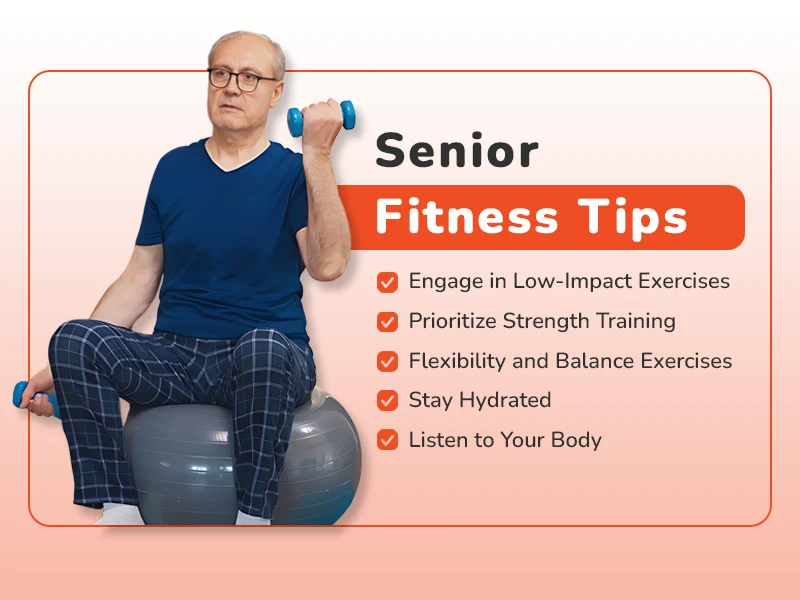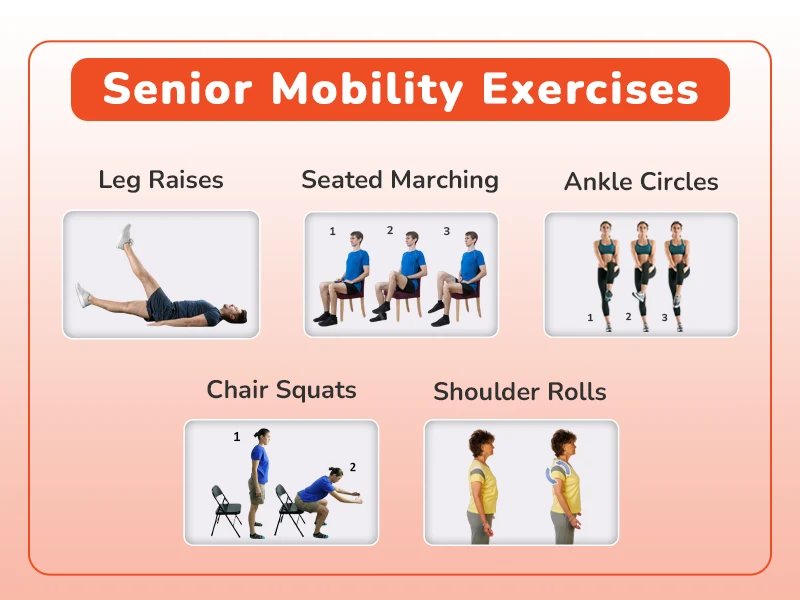Staying Active in Your Golden Years: Fitness and Mobility for Seniors
As we journey through life, one thing becomes abundantly clear – our golden years are a precious time to be cherished. It’s a phase where we can enjoy the fruits of our labor, savor the company of loved ones, and relish the beauty of a life well-lived. However, maintaining health and mobility is one prerequisite to truly savoring these moments. This article guides you to stay active and mobile in your senior years, ensuring you can make the most of this wonderful chapter of life.
The Importance of Senior Fitness
The golden years, often defined as the period beyond 60, mark a unique chapter in one’s life. It’s a phase characterized by well-earned wisdom, cherished memories, and the opportunity to focus on personal passions and interests. However, it’s also a time when the importance of senior fitness becomes increasingly evident. Maintaining an active lifestyle as a senior isn’t solely a matter of aesthetics or vanity; it’s a crucial component of your overall well-being. Let’s delve deeper into the significance of senior fitness:
- Preserving Independence: One of the most cherished aspects of life as a senior is the ability to live independently. Senior fitness plays a pivotal role in preserving this autonomy. Regular physical activity ensures you can continue to perform daily tasks, whether cooking a meal, running errands, or tending to your garden, without relying heavily on assistance.
- Enhancing Quality of Life: Your golden years should be brimming with joy, fulfilment, and memorable experiences. Maintaining a high level of physical fitness contributes to a better quality of life. It allows you to partake in activities you love, travel to new places, and spend quality time with friends and family. An active lifestyle can mean the difference between merely existing and thriving in your senior years.
- Adding More Years to Your Life: The adage “use it or lose it” holds in senior fitness. Regular physical activity improves your immediate well-being and can extend your life expectancy. Studies have shown that seniors who engage in fitness routines tend to live longer and enjoy a higher quality of life during their extended years.
- A Fountain of Youth: There’s a timeless charm associated with youthful exuberance, and senior fitness is your fountain of youth. It not only keeps your body agile but also sharpens your mind. Physical activity stimulates cognitive functions, enhances memory, and reduces mental decline.
In essence, senior fitness isn’t just a matter of staying active; it’s a key to unlocking a fulfilling, independent, and vibrant life during your golden years. It’s a way to cherish every moment, make new memories, and embrace life’s many adventures.
Senior Fitness Tips

1. Engage in Low-Impact Exercises
Low-impact exercises are the cornerstone of senior fitness. These activities are gentle on your joints while providing a significant workout. Walking, swimming, or tai chi boosts cardiovascular health and helps maintain muscle strength. These exercises are perfect for seniors looking to stay active without putting excessive strain on their bodies.
2. Prioritize Strength Training
Strength training is a key component of senior fitness. While it may sound intimidating, it’s incredibly beneficial. It helps preserve muscle mass, bone density, and overall strength. Our bodies lose muscle as we age, leading to weakness and a higher risk of falls. Consider incorporating resistance bands or light weights into your workouts to counteract this. Strength training exercises can be customized to your fitness level, making them accessible and effective.
3. Flexibility and Balance Exercises
Maintaining flexibility and balance becomes crucial for preventing falls and injuries as we age. Incorporating exercises that improve these aspects of fitness is vital. Yoga and stretching routines are excellent choices. These exercises enhance flexibility and contribute to better balance and coordination. They can help you stay agile and confident in your movements, reducing the risk of accidents or falls.
4. Stay Hydrated
While not an exercise per se, staying hydrated is a fundamental aspect of senior fitness. Proper hydration supports bodily functions, joint health, and overall well-being. Water is essential for maintaining the water content in the intervertebral discs, which cushion the spine, and it also helps in the lubrication of joints.
5. Listen to Your Body
The most critical fitness tip for seniors is to listen to your body. Pay attention to how you feel during and after exercise. Consult your healthcare provider if you experience pain, discomfort, or unusual symptoms. They can provide guidance and ensure your fitness routine is safe and effective.
Remember, senior fitness is about maintaining your health, enhancing your quality of life, and enjoying the activities you love. It’s a journey that adapts to your needs and capabilities, ensuring you can continue embracing a vibrant, active lifestyle well into your golden years.
Senior Mobility Exercises

1. Leg Raises
Leg raises are a simple yet effective way to strengthen your lower body muscles. To perform this exercise, stand behind a sturdy chair and hold on for support. Lift one leg to the side and lower it gently. Repeat this motion and then switch to the other leg. Leg raises help to improve the strength of your hips, thighs, and buttocks, which is crucial for mobility and balance.
2. Seated Marching
Seated marching is an excellent exercise to enhance leg strength and coordination. Begin by sitting on a stable chair with your feet flat on the floor. Lift your knees, one at a time, as if you’re marching in place while remaining seated. This exercise strengthens your leg muscles and contributes to better mobility, making activities like getting in and out of chairs or walking easier.
3. Ankle Circles
Ankle mobility is essential for stability and preventing falls. You can improve ankle mobility with ankle circles. Start by sitting comfortably in a chair and lift one leg off the ground. Then, rotate your ankle in a circular motion, first in one direction and then the other. After completing the set for one ankle, switch to the other. Ankle circles help maintain flexibility in your ankles, essential for walking and maintaining balance.
4. Chair Squats
Chair squats are an excellent exercise for strengthening your leg muscles and improving your ability to stand up from a seated position. Begin by standing in front of a stable chair with your feet shoulder-width apart. Slowly lower yourself toward the chair as if you were about to sit down, then immediately stand back up. Make sure to keep your knees aligned with your toes during the movement. Chair squats help enhance leg strength, making everyday movements more manageable.
5. Shoulder Rolls
Shoulder rolls are a gentle exercise to improve shoulder mobility and relieve tension. Sit or stand with your arms relaxed at your sides. Slowly roll your shoulders forward in a circular motion several times and reverse the direction. This exercise can help prevent stiffness in the shoulders and improve your range of motion, making it easier to reach for objects or perform daily tasks.
Incorporating these mobility exercises into your daily routine can help you maintain and improve your physical function as a senior. Remember to start slowly, and if you have any concerns or medical conditions, consult with your healthcare provider before beginning a new exercise program.
Healthy Aging Strategies
1. Stay Hydrated
Proper hydration is fundamental for overall health, especially as you age. Drinking adequate water throughout the day supports various bodily functions, including digestion, circulation, and temperature regulation. Dehydration can lead to various health issues, so it is a priority to stay hydrated by sipping water regularly.
Read More: Embracing the Golden Years: Tips for Active and Fulfilling Senior Living
2. Balanced Diet
Fueling your body with a well-balanced diet is key to healthy aging. Focus on incorporating various foods into your meals, including fruits, vegetables, whole grains, lean proteins, and healthy fats. These nutrient-dense foods provide essential vitamins, minerals, and antioxidants that support senior health. Maintaining a healthy weight through a balanced diet can help prevent chronic conditions such as diabetes and heart disease.
3. Regular Check-Ups
Regular check-ups with healthcare providers are a crucial aspect of healthy aging. These appointments allow healthcare professionals to monitor your health, detect potential issues early, and guide you on staying healthy. During check-ups, your healthcare provider may perform screenings, review your medications, and address any concerns you may have. Don’t skip these appointments, as they significantly maintain your well-being as a senior.
4. Exercise Your Mind
Just as physical fitness is important, keeping your mind active is essential for healthy ageing. Engage in activities challenging your cognitive abilities, such as puzzles, brain games, reading, or learning new skills. Mental stimulation can help preserve cognitive function and memory, contributing to a fulfilling and independent lifestyle in your golden years.
5. Social Connections
Maintaining social connections is a vital component of healthy aging. Loneliness and social isolation can have adverse effects on mental and emotional well-being. Stay connected with friends and family, participate in social activities, and join clubs or groups that align with your interests. Social interactions provide emotional support and promote a sense of belonging.
6. Manage Stress
Effective stress management is essential for overall health and well-being. Chronic stress can contribute to various health issues, including cardiovascular problems and weakened immune function. Practice stress-reduction techniques such as meditation, deep breathing exercises, mindfulness, or yoga to keep stress levels in check. Managing stress can enhance your mental and emotional health as you age.
7. Quality Sleep
Prioritize getting enough quality sleep each night. Sleep is essential for physical and mental restoration. Create a comfortable sleep environment, establish a consistent sleep routine, and aim for seven to nine hours of sleep per night. Quality sleep can improve memory, mood, and overall cognitive function.
Incorporating these healthy aging strategies into your lifestyle can promote a vibrant and fulfilling senior life. Remember that it’s never too late to adopt healthy habits and prioritize your well-being as you age.
Conclusion: Embrace Your Golden Years with Vigor
The golden years are a time to embrace life with vigor. By prioritizing senior fitness, mobility exercises, and healthy aging strategies, you can make these years some of your life’s most fulfilling and active. Stay active, stay mobile, and most importantly, stay happy. Your golden years are yours to enjoy to the fullest.



